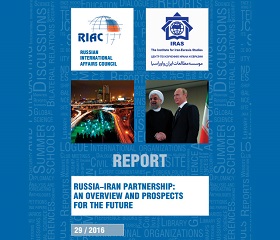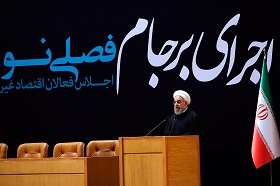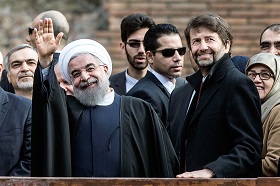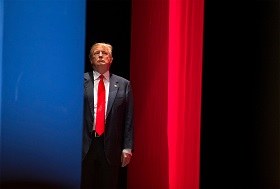Judging the Effects: The Shaping Iranian Perspective on JCPOA and Trump's Options
(votes: 1, rating: 2) |
(1 vote) |
Ph.D. in Political Science, Co-Lead the Regional Security Initiative at the Middle East Directions Programme of the Robert Schuman Centre for Advanced Studies at the European University Institute, Adjunct Professor of Middle Eastern Studies at the Graduate School of Universita’ Cattolica
The second year of Joint Comprehensive Plan of Action implementation is marked with serious uncertainty about its future. Critics in Tehran call the agreement ineffective and Trump considers it to be a historically bad negotiation. But as election days in Tehran approach, it's becoming more important to have a look at Iranian perspective on JCPOA. Iranian Public opinion positively reacted to JCPOA. This article is an inside view to provide a better understanding on how Iranian perception of JCPOA is shaping.
Introduction
The second year of Joint Comprehensive Plan of Action implementation is marked with serious uncertainty about its future. Critics in Tehran call the agreement ineffective and Trump considers it to be a historically bad negotiation. But as election days in Tehran approach, it's becoming more important to have a look at Iranian perspective on JCPOA. Iranian Public opinion positively reacted to JCPOA. People's support for JCPOA comes from a general belief that the deal could help the economy flourish, improve living standards, sustain their security and bring other tangible benefits. President Rouhani's strategy to correlate Iran's future prospects with the success of P5+1 negotiations was a tricky idea that plays a paramount role in shaping public expectations. It has been claimed that JCPOA will have direct positive effects on people's daily life. These claims played a significant role in gaining public support for the deal and gradually became the main tool to shape the judgment about JCPOA future and draft Iranian atomic policies. In fact, Iranians consider JCPOA effects to be the main element determining their fate. Ironically, president Rouhani's fate more than ever is depends on JCPOA's fate.
The so called "positive effects" became the center of heated debates in Tehran between pro-JCPOA government authorities and skeptical conservative political elites. The former dismissed the effects’ strategic importance, arguing the deal would not have much strategic effect on Iran as it is put by government. Moreover, there are serious doubts about US determination to fulfill its commitment. Gradually questions about JCPOA effects on Iran's economy and prosperity turned out to be the nodal points of debates in Tehran. Discussions about the "effects" which were held in more technical terms between political and bureaucratic elites behind the closed doors, leaked in mid-2016 and changed the public opinion from a more general belief on the good faith of JCPOA to a more investigative approach. Iranians are asking what the real effects of JCPOA are and why over a year after implementation day the president Rouhani claims that JCPOA’s positive effects are still not tangibly sensed.
President Rouhani's strategy to correlate Iran's future prospects with the success of P5+1 negotiations was a tricky idea that plays a paramount role in shaping public expectations.
The challenge of JCPOA effects becomes more serious when it is considered as a parameter to evaluate Government's policies and performance, hence acts as a pressure tool. Although it is true that hardliners are more marginalized in Iran's today's politics and benefit less from social support than before, more and more people ask about the real outcomes and effects of the nuclear deal, as do Rouhani’s rival groups. Nature of "effects" becomes yet more significant when simultaneously public opinion, parliament (Majlis) and hardline political fractions use them as an evaluation and judging tool. In this sense not only will the Iranian future atomic policies evolve around the notion of "JCPOA effectiveness", but Iranian presidential race next year will be affected as well. For Iranians, as long as the deal brings benefit to people and supports national interests, its sustainability is guaranteed but only with the commitments met by the US and European countries. Indeed even the policies of US president elect Donald Trump could be constrained within this perspective.
That is the main reason why the US and other international players need to consider "effects" of their sanction relief policies in line with maintaining JCPOA. Deal support clarifies differences between effective and formal way of meeting commitments as Iranians claim. This article is an inside view to provide a better understanding on how Iranian perception of JCPOA is shaping.
Concept of "Effects" in JCPOA
JCPOA’s final document introduces the concept of "Effects" as one of its main considerations. Effects are interpreted in two ways throughout the nuclear deal. E3/EU+3 side, sees its eligible effect and final outcome in dismantling weapon capabilities in Iran's nuclear program. In Iranian view, effect sought is assurance of gaining full economic benefit from sanctions relief. JCPOA will be prolonged if these two effects are met simultaneously on both sides. On E3/EU+3 side, there are defined procedures and mechanisms enforced by IAEA that could verify Iranian course of action. These verification measures enable E3/EU+3 to evaluate the level of effect achievement. To accomplish effects on the Iranian side there are certain articles including article 7 of Annex II that determines final effects of sanction’s relief in various subject areas. However there are fewer concrete objective measures to monitor and evaluate how relieved sanctions will result in intended effects. This less concrete evaluation possibility gives proper room for Iranian public and government oppositions to judge the effects based on their own interpretations rather than concrete indexes.
The fact is that there is a meaningful division between meeting commitments under article 4-6 of Annex II and reaching effects mentioned in Article 7 of Annex II. In this case, US relieved sanctions outcomes and their effects could be limited by auxiliary sanctions, remaining executive measures or other external factors outside the negotiated deal. This is exactly what many speculate as Trumps strategy for dealing with JCPOA: a twofold strategy of remaining in the deal at first but then limiting its functions and effectiveness. Thus, while formally the US is committed to JCPOA, the final effectiveness of lifted sanctions is manageable through remaining primary sanctions or other external factors.
Iranian debate, which is probably supported by analyzing OFAC course of action after implementation day, argues that even during Obama administration while the US commitments under article 4-6 of Annex II were met, the US political will remained the main factor in accomplishing effects mentioned under Article 7 of Annex II. In this perspective, Tehran considers JCPOA effects to be determining parameter for the judgment about the nuclear deal fact rather than its nominal implementation by other parties.
US Implementation of JCPOA with Limited Effects
Iranians are asking what the real effects of JCPOA are and why over a year after implementation day the president Rouhani claims that JCPOA’s positive effects are still not tangibly sensed.
For president elect Trump it could be very challenging to renegotiate a multilateral UN Security Council backed agreement like JCPOA, as it is costly to tear it up as he promised. However, as Suzanne Maloney suggests, Trump would not have to touch the deal to imperil it, but his administration is likely to adapt, using tactics aimed at intensifying pressure on Tehran across the board. If this is the case, then the main question is how the US could remain in the deal still limiting JCPOA's effects on Iran's economy to put more pressure. This is also a difficult task as it is clearly stated in JCPOA that "E3/EU+3 refrain from imposing exceptional or discriminatory regulatory and procedural requirements in lieu of the sanctions and restrictive measures covered by the JCPOA". But is there any possibility for the US to manage and limit effects mentioned under Article 7 of Annex II? In other words, how can the USA meet its commitments under JCPOA to the extent that retains the ability to manage effects in order to put more pressure on Iran and providing limiting scale of Iran’s benefits?
In the US sanctions regime, various sanctions are systematically related to each other to form a comprehensive and complementary structure. In this interrelated structure, implementation or relieving of specified articles in certain sanction code is a dependent variable. In this sense revoking a certain article mentioned in JCPOA by OFAC depends on how they may implement other articles in another sanction code which is not directly mentioned in JCPOA. That is why achieving full effects of sanction relief under JCPOA depends on sanction codes outside the deal itself and US administration’s political choice on how to implement articles related to external sanction codes.
Interactions between various elements of sanction regime may be referred to as Sanctions Structural Interactions. These interactions exist between three elements including sanctions contents, sanctions implementation/relief model and internal relations among sanction codes. Such structure enables US policy makers to achieve favored effects by maneuvering among these elements. Contents of various sanctions including statutes and executive orders are linked together in effect based network where implementation/relief models are introduced based on this linkage to optimize reaching foreign policy effects. Within this framework, accomplishing effects at JCPOA level is not only a variable of sanctions contents and implementation/relief models followed by US authorities. It also strategically depends on backdoor relations exits between various sanctions.
For example, although secondary sanctions are lifted based on the US commitments under JCPOA, non-US traders who are allowed to do business with Iran in compliance with JCPOA are still facing the risk of primary sanctions in banking transactions with their Iranian partners [1]. These interlinked relations influence the final effects obtained. Relations network among sanctions complicates judgment about the US complying with its commitments and increases assumptions that the US my use these less tangible aspects of sanctions based on its political will. This argument is gaining more support in Tehran.
That is why achieving full effects of sanction relief under JCPOA depends on sanction codes outside the deal itself and US administration’s political choice on how to implement articles related to external sanction codes.
Sanctions implementation/relief models followed by the US government contribute to JCPOA final effects. According to documents published by OFAC including FAQ and "Guidance Relating to the Lifting of Certain US Sanctions", the US authorities mostly concentrate on reaffirming persistence of remaining sanctions i.e. primary sanctions. In fact, a number of documents explain how remaining sanctions function rather than clarify ambiguities surrounding sanction relief. This secures legitimate right of the US government to secure its sanction regime and enforce it as strongly as before. However, Tehran believes this approach could create a strange environment for potential Iran's business partners. By focusing more on the remaining sanctions in documents published to lift them, they complicate Iranian partners’ anticipations about sustainability and reliability of Iran’s future. As a result, despite US compliance with the deal terms, its less transparent, non-affirmative and complex sanction relief models acts as a source of confusion for Iranian side.
JCPOA Effects and Trump’s Options
What president elect Trump can do with these three elements of Sanctions Structural Interactions model includes enriching sanctions contents with dozens of new bills against Iran, or as he previously mentioned, strengthening sanctions implementation/relief mechanism. Finally, he can use the benefit from relations between primary and secondary sanctions to put pressure on Iranian economic partners. All these measures should they prove successful, limit the effectiveness of JCPOA for Iranian side. But then the problem for the new US administration will transform into a more complex one as Iran is determined to draft its counter measures based on the concept of effectiveness. Iran could challenge the US by focusing on American failure to meet their commitments referring to article 7 of Annex II and escalate the problem. In other words, though the US in Trump era could put more pressure on Iran by reducing the effectiveness of JCPOA being still formally committed to the deal, Iran will receive a brilliant opportunity to challenge the US with the concept of "effectiveness". All this contributes to further uncertainty about the faith of the agreement.
The situation gets more complicated when Sanctions Structural Interactions framework shows that the US could use both network of relations among sanctions and implementation/relief models to mediate or limit final effects of JCPOA on Iranian economy without withdrawing from the deal. It means that while the US is complying with its commitments under JCPOA by revoking certain sanctions, the effects specified in Article 7 of Annex II could be partially fulfilled. However, this policy sounds tricky as both Iranian public opinion and political elites in Tehran are getting alarmed about the real outcomes and effects of nuclear deal. Trump’s aggressive options against JCPOA will probably lead to following Iranian moves:
1. Transforming effectiveness as the cornerstone of Iranian approach to JCPOA limits future US options, which are based on putting more pressure on Iran by adding new surrogate sanctions. This is due to Iranian readiness to use deal terms to prove US failure in effective relief and mark it as violation. Enforcing new sanctions on other areas like human rights or Iran's regional policies with regard to JCPOA effectiveness, would be considered violation of Article 7 of Annex II and will lead to activation of Iran's counter strategies.
Despite US compliance with the deal terms, its less transparent, non-affirmative and complex sanction relief models acts as a source of confusion for Iranian side.
2. The policy to stimulate Iran to withdraw from the deal because of its ineffectiveness is far from reality. As Iranian patience and its strategic logic show, foreign policy moves are becoming more rational and calculated. Although JCPOA being weak is a sign of failed deal for Iran, there is general consensus in Tehran that the country is not going to leave the deal unilaterally. Iran's growing awareness of an effective JCPOA importance leads to a new wave of strategies and tactics to bring back the effectiveness to the deal, a move that contradicts those who are hopeful about Iran's withdrawal under pressure.
3. Good faith on negotiations and readiness to reach compromise in lieu of direct confrontation with the West is a distinctive feature of Iranian moderate forces. JCPOA is the most significant accomplishment of the moderate discourse, which was achieved by full size national support. But JCPOA ineffectiveness which then translates into its failure is a dream for Iranian hardliners, proving their attitudes and paving their way for another reemergence on next year's presidential race. JCPOA fate will have an important impact on the dynamics of Iranian internal political forces which influence regional order.
Conclusion
By current trend, JCPOA effects defined by Iranian side as the opportunity to gain full economic benefit of lifted sanctions is gaining more importance both among Iranian public opinion and political elite. Effects as illustrated in article 7 of Annex II are gradually turning out to be the main foundation of any judgment about the deal to the extent that Rouhani government is under pressure to adjust its policies in accordance with deal's effects rather than its formal terms. This dynamic acts as a strategic limitation both for president Rouhani and president elect Trump. It’s a limitation for Rouhani as his nuclear policies are judged by economic effects they bring for the country. Judging the effects is also a limitation for Trump as his policies to reduce the deal’s effectiveness could trigger unprecedented reactions from Tehran.
Resource balance and cost benefit calculations were the prime logic that brought Iran to negotiations. The benefits Iran receives from its cooperation within international order would be the main element that facilitates further future cooperation on wider issues, and the country's integration into world politics. This reveals the value of an effective JCPOA that encourages Iranians to cooperate with international community by facilitating their access to full benefit of lifted sanctions. This is a major counterargument against hardliners who claim that international order serves against national interests. It will prove the idea that acting within rules of international community serves Iran's national security interests better than revolutionary standings. However, less effective JCPOA is challenging this logic strategically as it may transform Iranian political rationality for years to come.
Footnotes
1. Moarefy, Sahand. (2016). Partially Unwinding Sanctions: The Problematic Construct of Sanctions Relief in the JCPOA, National Security Journal, Harvard Law School
(votes: 1, rating: 2) |
(1 vote) |








